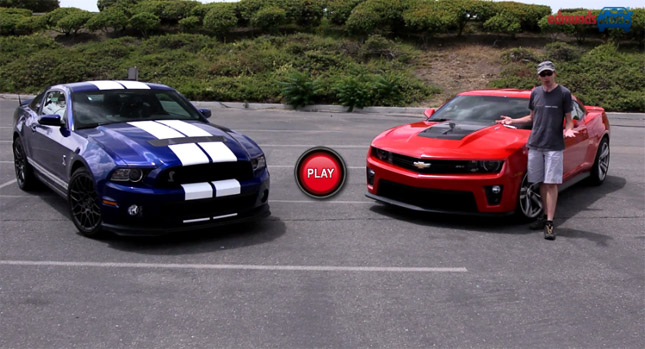Whichever way you crunch the numbers, the new 2013 Ford Shelby GT500 owns the 2012 Chevrolet Camaro ZL1 when it comes to sheer power.
According to their respective manufacturers, at the flywheel, the $54,995 Camaro ZL1’s 6.2-liter supercharged V8 produces 580hp at 6,000 rpm and 556 lb.-ft. (754 Nm) at 4,200 rpm, while the $54,200 Shelby GT500’s 5.8-liter supercharged V8 delivers 662hp at 6,250 rpm and 631 lb.-ft. (856Nm) at 4,000 rpm.
In a recent dyno test from Inside Line, the Camaro ZL1 delivered 497hp and 497 lb-ft (673Nm) on the rear wheels, while the Shelby GT500, 595hp and 602 lb-ft (815Nm) respectively.
 So, how do these numbers translate on the road? Well, after drawing their swords on the dyno, Inside Line took the two cars to the track, and the results are both expected and to some extent, surprising.
So, how do these numbers translate on the road? Well, after drawing their swords on the dyno, Inside Line took the two cars to the track, and the results are both expected and to some extent, surprising.
Naturally, the more powerful Ford was faster than the Chevy recording a 0-60mph (96km/h) time of 4.0 seconds and completing the quarter mile (400m) in 11.9 seconds with an exit speed of 123.5mph (198.7 km/h).
That’s compared to the ZL1’s 4.4 second 0-60mph run and 12.4 seconds @ 114.7mph (184.6 km/h) for the 1/4 mile.
But when it came to handling, the ZL1 came on top.
In fact, with a 1.03g average lateral acceleration performance on the skid pad, the Camaro ZL1 not only beat the Shelby GT500’s 0.98g but also the Corvette ZR1 and matched the McLaren MP4-12C and Porsche 911 GT2 RS for the highest lateral acceleration ever recorded by the online magazine.
The ZL1 was also faster through the slalom recording a speed of 70.8mph (113.9km/h) versus 69.1mph (111.2km/h) for the Shelby GT500.
The Ford, however, stopped from 60mph (96km/h) in 109 feet (32.2m) versus 110 feet (33.5m) for the Camaro.
We should mention that the Shelby GT500 tested by IL was equipped with the optional SVT Performance package, SVT Track Pack and Recaro seats that added $8,085 to the list price, while the Camaro ZL1 was fitted with a $500 Interior Microfiber package, $470 bright forged wheels and a $600 carbon-fiber hood insert.
For more a detailed presentation of the comparison test, check out IL’s video that follows after the break.
VIDEO







